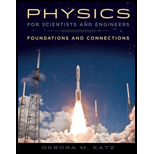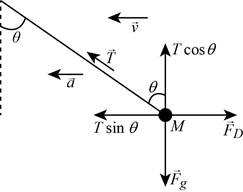
Concept explainers
(a)
The angle of the rope with the vertical.
(a)
Answer to Problem 44PQ
The angle of the rope with the vertical is
Explanation of Solution
Assume the man as a particle of mass
The following figure gives the direction of all forces on the man.

Apply equilibrium condition of forces along
Here,
Write the expression for net forces along
Here,
From figure1, expand equation (I) using all forces along
Here,
Rearrange above equation to get
From figure1, expand equation (II) using all forces along
Here,
Rearrange above equation to get
Divide equation (IV) by (III) to get
In problem it is allowed to ignore effect of air drag force.
Substitute
Conclusion:
Substitute
Therefore, the angle of the rope with the vertical is
(b)
The expression for the angle made by the rope with the vertical as a function of time by considering drag force due to air.
(b)
Answer to Problem 44PQ
The expression for the angle made by the rope with the vertical as a function of time by considering drag force due to air is
Explanation of Solution
Write the expression for the drag force.
Here,
Since man is modeled as a particle of dimeter
Write the expression for the velocity of the particle at each instant of time.
Here,
Conclusion:
Substitute
Substitute
Substitute
Substitute
Therefore, the expression for the angle made by the rope with the vertical as a function of time by considering drag force due to air is
(c)
Whether terminal speed is a meaningful concept for this situation and explain the reason.
(c)
Answer to Problem 44PQ
Terminal speed is not a meaningful concept for this situation since helicopter provides net acceleration at every time and never reaches a zero net force situation.
Explanation of Solution
Terminal speed is constant speed attained by a body moving in a fluid so that drag force is proportional to velocity of the body. Consider situation of a body moving through a fluid. The forces acting are gravitational force and drag force. Gravitational force is a constant force whereas drag force depends on velocity of the body at each instant of time. At particular point when drag force equal to gravitational force the body takes constant velocity.
In this case drag force depends on square of velocity of the body. As the drag force increases the helicopter exerts more force to provide constant acceleration
(d)
The effect on tension if the helicopter continues to accelerate and the result for a real rope in this situation.
(d)
Answer to Problem 44PQ
The tension in the helicopter is inversely proportional to cosine of angle made by the rope with the vertical. As helicopter accelerates, angle made by the rope with the vertical increases. Thus, tension in the rope increases as the helicopter accelerates.
Explanation of Solution
Rearrange equation (III) to get
Therefore, tension in the rope continues to increase as the helicopter accelerates. A real rope has certain limit to withstand tension. After a particular value it will break.
Want to see more full solutions like this?
Chapter 6 Solutions
Physics for Scientists and Engineers: Foundations and Connections
- An electromagnetic wave is traveling through vacuum in the positive x direction. Its electric field vector is given by E=E0sin(kx−ωt)j^,where j^ is the unit vector in the y direction. If B0 is the amplitude of the magnetic field vector, find the complete expression for the magnetic field vector B→ of the wave. What is the Poynting vector S(x,t), that is, the power per unit area associated with the electromagnetic wave described in the problem introduction? Give your answer in terms of some or all of the variables E0, B0, k, x, ω, t, and μ0. Specify the direction of the Poynting vector using the unit vectors i^, j^, and k^ as appropriate. Please explain all stepsarrow_forwardAnother worker is performing a task with an RWL of only 9 kg and is lifting 18 kg, giving him an LI of 2.0 (high risk). Questions:What is the primary issue according to NIOSH?Name two factors of the RWL that could be improved to reduce risk.If the horizontal distance is reduced from 50 cm to 30 cm, how does the HM change and what effect would it have?arrow_forwardTwo complex values are z1=8 + 8i, z2=15 + 7 i. z1∗ and z2∗ are the complex conjugate values. Any complex value can be expessed in the form of a+bi=reiθ. Find r and θ for z1z2∗. Find r and θ for z1/z2∗? Find r and θ for (z1−z2)∗/z1+z2∗. Find r and θ for (z1−z2)∗/z1z2∗ Please explain all steps, Thank youarrow_forward
- An ac series circuit consists of a voltage source of frequency 60 Hz and voltage amplitude V, a 505-Ω resistor, and a capacitor of capacitance 7.2 μF. What must be the source voltage amplitude V for the average electrical power consumed in the resistor to be 236 W? There is no inductance in the circuit.arrow_forwardAn L−R−C series circuit has R= 280 Ω . At the frequency of the source, the inductor has reactance XLL= 905 Ω and the capacitor has reactance XC= 485 Ω . The amplitude of the voltage across the inductor is 445 V . What is the amplitude of the voltage across the resistor and the capacitor? What is the voltage amplitude of the source? What is the rate at which the source is delivering electrical energy to the circuit?arrow_forwardA 0.185 H inductor is connected in series with a 98.5 Ω resistor and an ac source. The voltage across the inductor is vL=−(12.5V)sin[(476rad/s)t]vL. Derive an expression for the voltage vR across the resistor. Express your answer in terms of the variables L, R, VL (amplitude of the voltage across the inductor), ω, and t. What is vR at 2.13 ms ? Please explain all stepsarrow_forward
- A worker lifts a box under the following conditions:Horizontal distance (H): 30 cmInitial height (V): 60 cmVertical travel (D): 50 cmTorso rotation (A): 30°Frequency: 3 times/minute for 1 hourGrip: Good Question:What is the RWL for this task?What does this value mean in terms of occupational safety?arrow_forwardCan someone helparrow_forwardCan someone help mearrow_forward
- 3. Four identical small masses are connected in a flat perfect square. Rank the relative rotational inertias (IA, IB, IC) about the three axes of rotation shown. Axes A and B are in the plane of the square, and axis C is perpendicular to the plane, through mass m1. ΙΑ IB m2 m1 m3 Ic m4 (a) IAarrow_forwardConsider the circuit shown in the figure below. (Assume L = 5.20 m and R2 = 440 Ω.) (a) When the switch is in position a, for what value of R1 will the circuit have a time constant of 15.4 µs? (b) What is the current in the inductor at the instant the switch is thrown to position b?arrow_forwardCan someone helparrow_forwardarrow_back_iosSEE MORE QUESTIONSarrow_forward_ios
 Physics for Scientists and Engineers: Foundations...PhysicsISBN:9781133939146Author:Katz, Debora M.Publisher:Cengage Learning
Physics for Scientists and Engineers: Foundations...PhysicsISBN:9781133939146Author:Katz, Debora M.Publisher:Cengage Learning Principles of Physics: A Calculus-Based TextPhysicsISBN:9781133104261Author:Raymond A. Serway, John W. JewettPublisher:Cengage Learning
Principles of Physics: A Calculus-Based TextPhysicsISBN:9781133104261Author:Raymond A. Serway, John W. JewettPublisher:Cengage Learning University Physics Volume 1PhysicsISBN:9781938168277Author:William Moebs, Samuel J. Ling, Jeff SannyPublisher:OpenStax - Rice University
University Physics Volume 1PhysicsISBN:9781938168277Author:William Moebs, Samuel J. Ling, Jeff SannyPublisher:OpenStax - Rice University Physics for Scientists and EngineersPhysicsISBN:9781337553278Author:Raymond A. Serway, John W. JewettPublisher:Cengage Learning
Physics for Scientists and EngineersPhysicsISBN:9781337553278Author:Raymond A. Serway, John W. JewettPublisher:Cengage Learning Physics for Scientists and Engineers with Modern ...PhysicsISBN:9781337553292Author:Raymond A. Serway, John W. JewettPublisher:Cengage Learning
Physics for Scientists and Engineers with Modern ...PhysicsISBN:9781337553292Author:Raymond A. Serway, John W. JewettPublisher:Cengage Learning College PhysicsPhysicsISBN:9781938168000Author:Paul Peter Urone, Roger HinrichsPublisher:OpenStax College
College PhysicsPhysicsISBN:9781938168000Author:Paul Peter Urone, Roger HinrichsPublisher:OpenStax College





